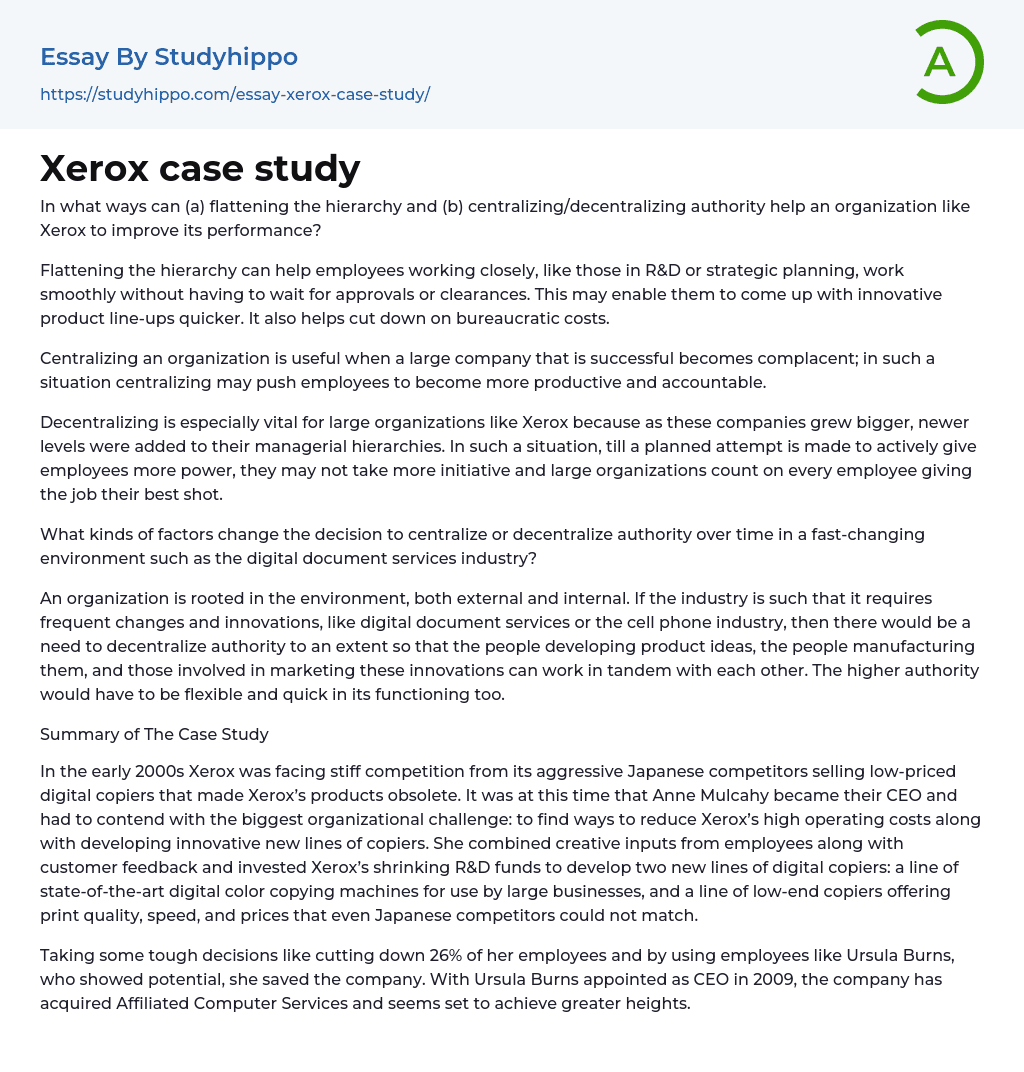In what ways can (a) flattening the hierarchy and (b) centralizing/decentralizing authority help an organization like Xerox to improve its performance?
Flattening the hierarchy can help employees working closely, like those in R&D or strategic planning, work smoothly without having to wait for approvals or clearances. This may enable them to come up with innovative product line-ups quicker. It also helps cut down on bureaucratic costs.
Centralizing an organization is useful when a large company that is successful becomes complacent; in such a situation centralizing may push employees to become more productive and accountable.
Decentralizing is especially vital for large organizations like Xerox because as these companies grew bigger, newer levels were added to their managerial hierarchies. In such a situation, till a planned attempt is made to activel
...y give employees more power, they may not take more initiative and large organizations count on every employee giving the job their best shot.
What kinds of factors change the decision to centralize or decentralize authority over time in a fast-changing environment such as the digital document services industry?
An organization is rooted in the environment, both external and internal. If the industry is such that it requires frequent changes and innovations, like digital document services or the cell phone industry, then there would be a need to decentralize authority to an extent so that the people developing product ideas, the people manufacturing them, and those involved in marketing these innovations can work in tandem with each other. The higher authority would have to be flexible and quick in its functioning too.
Summary of The Case Study
I
the early 2000s Xerox was facing stiff competition from its aggressive Japanese competitors selling low-priced digital copiers that made Xerox’s products obsolete. It was at this time that Anne Mulcahy became their CEO and had to contend with the biggest organizational challenge: to find ways to reduce Xerox’s high operating costs along with developing innovative new lines of copiers. She combined creative inputs from employees along with customer feedback and invested Xerox’s shrinking R&D funds to develop two new lines of digital copiers: a line of state-of-the-art digital color copying machines for use by large businesses, and a line of low-end copiers offering print quality, speed, and prices that even Japanese competitors could not match.
Taking some tough decisions like cutting down 26% of her employees and by using employees like Ursula Burns, who showed potential, she saved the company. With Ursula Burns appointed as CEO in 2009, the company has acquired Affiliated Computer Services and seems set to achieve greater heights.
- Chief Executive Officer essays
- Convenience Store essays
- Firm essays
- Training And Development essays
- Unilever essays
- Variable Cost essays
- Virgin Group essays
- Bargaining essays
- Entity essays
- Pest analysis essays
- Advertising essays
- Audience Theory essays
- Competitor Analysis essays
- Consumer essays
- Marketing Management essays
- Marketing Mix essays
- Marketing Plan essays
- Marketing Research essays
- Marketing Strategy essays
- Point Of Sale essays
- Price essays
- Procurement essays
- Product essays
- Product Differentiation essays
- Promotion essays
- Promotion And Marketing Communications essays
- Retailing essays
- Trademark essays
- Anheuser-busch essays
- Brands essays
- Detergent essays
- Product Placement essays
- Research Design essays
- New Product Development essays
- Advertisement essays
- Brand essays
- Sales Promotion essays
- Advertising campaign essays
- Consumer behaviour essays
- Offer And Acceptance essays
- Wal-Mart essays
- Discover essays
- John Locke essays
- 9/11 essays
- A Good Teacher essays
- A Healthy Diet essays
- A Modest Proposal essays
- A&P essays
- Academic Achievement essays
- Achievement essays




